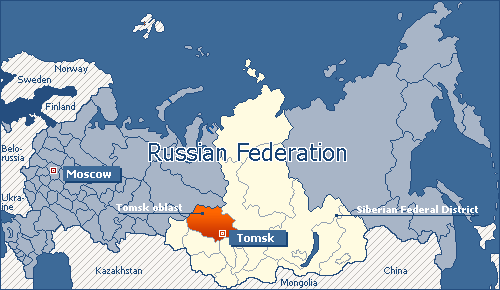Tomsk Oblast
Tomsk oblast is one of the most dynamically developed regions of Russia. The economics of the oblast has a differential structure, where oil and gas industry and science intensive branches predominate.

| Status | A constituent entity of the Russian Federation, part of Siberian Federal District |
| Official language | Russian |
| Time zone | MSK+3 (UTC+6, in summer UTC+7) |
| Telephone code of Tomsk | +7 382-2 |
| Geography | |
| Location | Western Siberia (latitude 56-61° north, longitude 75-80° east) |
| Area | 314 400 km2 (1,8 % of the territory of the Russian Federation, 16th position among the constituent entities of the RF), over 85% of the territory is regarded as difficult of access and similar to territories of Far North |
| Administrative center | Tomsk (56° 30'31'' of North latitude and 84° 58'47'' of East longitude, it was founded in 1604, population is 507,4 thousands of people, distance as far as Moscow is 3500 km by the railway) |
| Contiguous constituent entities of the Russian Federation | Krasnoyarsk Territory (in the East), Kemerovo and Novosibirsk Oblasts (in the South), Omsk and Tyumen Oblasts (in the West), Khanty-Mansi Autonomous District (in the North-West and in the North) |
| Climate | Extremely continental, average annual temperature -0,6 degree C in the South, up to -3,5 degree C in the North-East |
| The highest point | +274 m abowe the sea level |
| The lowest point | +34 m abowe the sea level |
| Forests | Forests cover 63 % of the territory. Total timber reserves are 2,6 bn m3. The annual trade stock stock of wild-growing plants (berries, mushrooms, cedar nuts, herbs, etc) in money equivalent is about 100 bn US dollars |
| The largest rivers | The Ob, the Tom, the Ket, the Chulym. |
| The largest lake | The Mirnoe, 18,3 km2 |
| The largest swamp | The Vasyugan swamp with the area 53,000 km2 (the largest swamp in the world) |
| Natural resources | Oil, gas, peat, kaolin, refractory clays, glass-making sands, ilmenite-zirconium sands, iron ores, bauxites, brown coal, zinc; minor deposits of gold, platinum, titanium and zirconium |
| Population | |
| Population as of January 1, 2017 | 1,078,900 people (0,7% of the population of Russia). |
| Population density | 3,4 people per 1 km2 |
| Average age | 38 years old |
| Urban population | 69%. |
| Ethnic composition | The Russians - 91%, the Tartars, the Ukrainians, the Germans, the Chuvashes, the Belarusians, the Bashkirs and the Jews (2.0-0.1%), about 80 nationalities in total, national minorities - the Chulyms and the Kets (less than 100 people) |
| Political system | |
| Executive power | Administration of Tomsk Oblast |
| Head of the executive power | Head of the Administration (Governor) of Tomsk Oblast, Sergey A. Zhvachkin (since 2012) |
| Legislative power | Legislative Duma of Tomsk Oblast (42 deputies) |
| Head of the legislative power | Chairman of the Legislative Duma of Tomsk Oblast, Oksana V. Kozlovskaya (since 2011) |
| Administrative division | 4 urban districts, 16 municipal districts (include 3 urban and 117 rural settlements, 576 villages). 140 municipal formations |
| Economics | |
| Economic region | West-Siberian |
| Gross Regional Product (GRP) in 2010 (in basic prices) | 281.7 billion rubles (almost 1% of the Russian GDP) |
| Export in 2010 | 612.7 million US dollars |
| Import in 2010 | 172.5 million US dollars. |
| Leading industries | Mechanical engineering and metal processing, oil and gas production, chemical, forest and woodworking, food, agriculture (wheat, rye, barley; dairy and meat cattle breeding, pig-breeding, poultry-keeping), fishery, fur trade and farming |
| Main industrial centers | Tomsk, Seversk, Asino, Kolpashevo, Strezhevoy |
| Transport | |
| Highways | 6405 km of hard surface roads; two district centers (Alexsandrovskoe, Bely Yar) and two towns (Strezhevoy and Kedrovy) do not have hard-surface road links with Tomsk; in November-March "winter roads" are used to deliver goods to the Oblast North. |
| Railways | 345 km, the main line Bely Yar-Tomsk-Taiga |
| Inland navigation | About 5000 km in the basin of the river Ob and its inflows (duration of the navigation period is 170-180 days) |
| Air communication | The main airports are in Tomsk and Strezhevoy,; mainly passenger traffic |
| Mains voltage | 220 V, 50 Hz |
